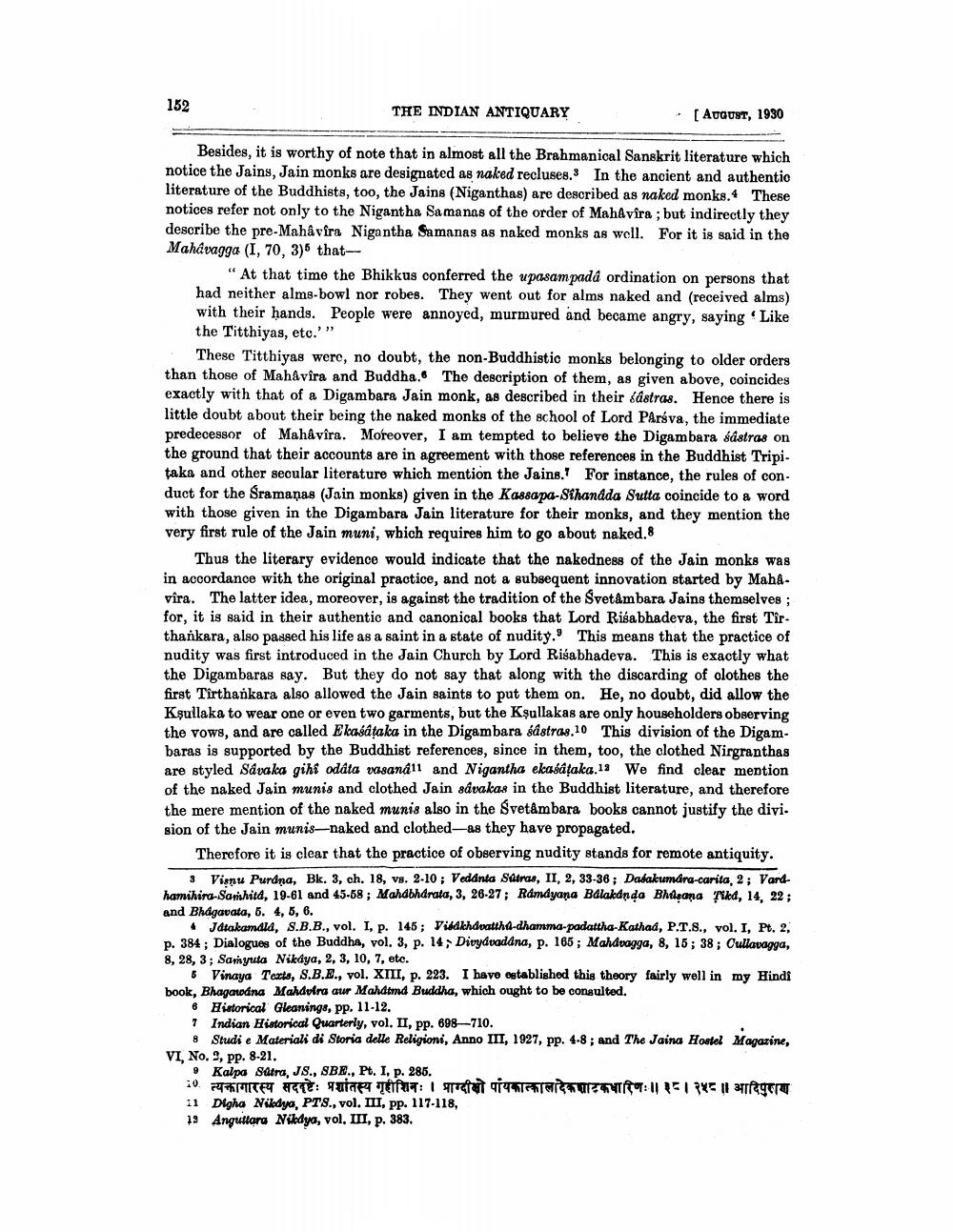________________
152
THE INDIAN ANTIQUARY
. [August, 1930
Besides, it is worthy of note that in almost all the Brahmanical Sanskrit literature which notice the Jains, Jain monks are designated as naked recluses. In the ancient and authentio literature of the Buddhists, too, the Jains (Niganthas) are described as naked monks. These notices refer not only to the Nigantha Samanas of the order of Mahavira ; but indirectly they describe the pre-Mahavira Nigantha Samanas as naked monks as well. For it is said in the Mahavagga (I, 70, 3)6 that
"At that time the Bhikkus conferred the upasampadd ordination on persons that had neither alms-bowl nor robes. They went out for alms naked and (received alms) with their hands. People were annoyed, murmured and became angry, saying "Like the Titthiyas, etc.'"
These Titthiyas wero, no doubt, the non-Buddhistio monks belonging to older orders than those of Mahavira and Buddha. The description of them, as given above, coincides exactly with that of a Digambara Jain monk, as described in their lastras. Hence there is little doubt about their being the naked monks of the school of Lord Paráva, the immediate predecessor of Mahâvîra. Moreover, I am tempted to believe the Digambara sástras on the ground that their accounts are in agreement with those references in the Buddhist Tripi. taka and other secular literature which mention the Jains. For instance, the rules of conduct for the Šramaņas (Jain monks) given in the Kassapa-Sihandda Sutta coincide to a word with those given in the Digambara Jain literature for their monks, and they mention the very first rule of the Jain muni, which requires him to go about naked.8
Thus the literary evidence would indicate that the nakedness of the Jain monks was in accordance with the original practice, and not a subsequent innovation started by Mahavîra. The latter idea, moreover, is against the tradition of the Svetambara Jains themselves ; for, it is said in their authentic and canonical books that Lord Risabhadeva, the first Tîr. thankara, also passed his life as a saint in a state of nudity.' This means that the practice of nudity was first introduced in the Jain Church by Lord Risabhadeva. This is exactly what the Digambaras say. But they do not say that along with the discarding of clothes the first Tirthankara also allowed the Jain saints to put them on. He, no doubt, did allow the Kşullaka to wear one or even two garments, but the Kşullakas are only householders observing the vows, and are called Ekasataka in the Digambara ódstras.10 This division of the Digambaras is supported by the Buddhist references, since in them, too, the clothed Nirgranthas are styled Savaka gihi odata vasandil and Nigantha ekašataka.12 We find clear mention of the naked Jain munis and clothed Jain sävakas in the Buddhist literature, and therefore the mere mention of the naked munis also in the Svetambara books cannot justify the divi. sion of the Jain munis-naked and clothed-as they have propagated.
Therefore it is clear that the practice of observing nudity stands for remote antiquity.
3 Visnu Purdna, Bk. 3, ch. 18, vs. 2-10 ; Vedanta Sutras, II, 2, 33-38; Dasakumara-carita, 2 ; Vardhamihira-Sarihitd, 19-61 and 45-68; Mahdbhdrata, 3, 26-27; Ramdyana Bdlakdndo Bhalgona Tiked, 14. 22; and Bhagavata, 5. 4, 5, 6.
4 Jdtakamdia, S.B.B., vol. I, p. 145; Vildkhdpatthd-dhamma-padattha-Kathad, P.T.S., vol. I. Pt. 2, p. 384 ; Dialogues of the Buddha, vol. 3, p. 14; Divyávadána, p. 165; Mahdvagga, 8, 15; 38; Cullavagga, 8, 28, 3; Samyuta Nikaya, 2, 3, 10, 7, etc.
6 Vinaya Texts, S.B.E., vol. XIII, p. 223. I have established this theory fairly well in my Hindi book, Bhagawana Mandvira aur Mahdimd Buddha, which ought to be consulted.
6 Historical Gleanings, pp. 11-12. 7 Indian Historical Quarterly, vol. II, pp. 698710.
8 Studi e Materiali di Storia delle Religioni, Anno III, 1927, pp. 4-8; and The Jaina Hostel Magazine, VI, No. 2, pp. 8-21.
• Kalpa Satra, JS., SBE., Pt. I. p. 286. 10. त्यकागारस्य सददृष्टेः प्रशांतस्य गृहीशिनः । प्राग्दीको पायकाकालादेकपाटकधारिणः।।३।२५८ ॥ आदिपुराण 11 Digha Nikdya, PTS., vol. III, pp. 117-118, 19 Anguttara Nikdya, vol. III, p. 383.




